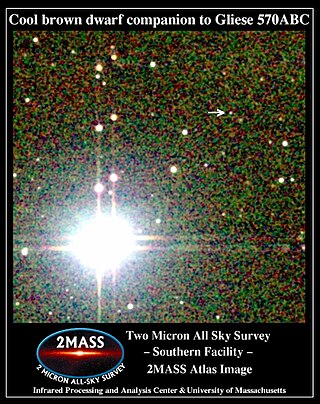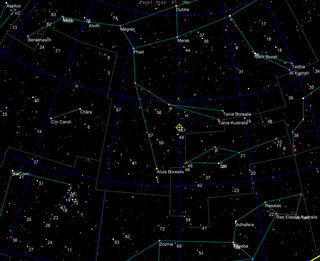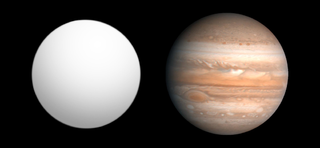Related Research Articles

Gliese 570 is a quaternary star system approximately 19 light-years away. The primary star is an orange dwarf star. The other secondary stars are themselves a binary system, two red dwarfs that orbit the primary star. A brown dwarf has been confirmed to be orbiting in the system. In 1998, an extrasolar planet was thought to orbit the primary star, but it was discounted in 2000.

47 Ursae Majoris, formally named Chalawan, is a yellow dwarf star approximately 45.3 light-years from Earth in the constellation of Ursa Major. As of 2011, three extrasolar planets are believed to orbit the star.

Gliese 876 is a red dwarf star 15.2 light-years away from Earth in the constellation of Aquarius. It is one of the closest known stars to the Sun confirmed to possess a planetary system with more than two planets, after GJ 1061, YZ Ceti, Tau Ceti, and Wolf 1061; as of 2018, four extrasolar planets have been found to orbit the star. The planetary system is also notable for the orbital properties of its planets. It is the only known system of orbital companions to exhibit a near-triple conjunction in the rare phenomenon of Laplace resonance. It is also the first extrasolar system around a normal star with measured coplanarity. While planets b and c are located in the system's habitable zone, they are giant planets believed to be analogous to Jupiter.

Gliese 436 is a red dwarf located 31.9 light-years away in the zodiac constellation of Leo. It has an apparent visual magnitude of 10.67, which is much too faint to be seen with the naked eye. However, it can be viewed with even a modest telescope of 2.4 in (6 cm) aperture. In 2004, the existence of an extrasolar planet, Gliese 436 b, was verified as orbiting the star. This planet was later discovered to transit its host star.
HD 130322 is a star with a close orbiting exoplanet in the constellation of Virgo. The distance to this system is 104 light years, as determined using parallax measurements. It is drifting closer to the Sun with a radial velocity of −12.4 km/s. With an apparent visual magnitude of 8.04, it is too dim to be visible to the naked eye; requiring binoculars or a small telescope to view. Being almost exactly on the celestial equator the star is visible everywhere in the world except for the North Pole. The star shows a high proper motion, traversing the celestial sphere at an angular rate of 0.197 arcsec yr−1.
HD 28185 is a yellow dwarf star similar to the Sun located 128 light-years away from Earth in the constellation Eridanus. The designation HD 28185 refers to its entry in the Henry Draper catalogue. The star is known to possess one long-period extrasolar planet.

XO-1 is a magnitude 11 G-type main-sequence star located approximately 530 light-years away in the constellation Corona Borealis. XO-1 has a mass and radius similar to the Sun. In 2006 the extrasolar planet XO-1b was discovered orbiting XO-1 by the transit method using the XO Telescope.
HD 11964 is a binary star system located 110 light-years away from the Sun in the equatorial constellation of Cetus. It is visible in binoculars or a telescope but is too faint to be seen with the naked eye, having an apparent visual magnitude of 7.51. The system is drifting closer to the Sun with a radial velocity of −9 km/s. Two extrasolar planets have been confirmed to orbit the primary.
Gliese 86 is a K-type main-sequence star approximately 35 light-years away in the constellation of Eridanus. It has been confirmed that a white dwarf orbits the primary star. In 1998 the European Southern Observatory announced that an extrasolar planet was orbiting the star.

HAT-P-3b, also named Teberda, is an extrasolar planet that orbits the star HAT-P-3 approximately 450 light-years away in the constellation of Ursa Major. It was discovered by the HATNet Project via the transit method and confirmed with Doppler spectroscopy, so both its mass and radius are known quite precisely. Based on these figures it is predicted that the planet has about 75 Earth masses' worth of heavy elements in its core, making it similar to the planet HD 149026 b.
XO-5 is a yellow dwarf main sequence star located approximately 910 light-years away from Earth in the Lynx constellation. It has a magnitude of about 12 and cannot be seen with the naked eye but is visible through a small telescope.
HIP 12961 is a star with an exoplanetary companion in the equatorial constellation of Eridanus. It is too faint to be visible to the naked eye, with an apparent visual magnitude of 10.24. The distance to this system can be estimated from its parallax measurements, which yield a separation of 76.3 light-years from the Sun. It is receding with a radial velocity of +33 km/s and has a high proper motion, traversing the celestial sphere at an angular rate of 0.300″ yr−1.

WASP-19b, formally named Banksia, is an exoplanet, notable for possessing one of the shortest orbital periods of any known planetary body: 0.79 days or approximately 18.932 hours. It has a mass close to that of Jupiter, but by comparison has a much larger radius ; making it nearly the size of a low-mass star. It orbits the star WASP-19 in the Vela constellation. At the time of discovery it was the shortest period hot Jupiter discovered as planets with shorter orbital periods had a rocky, or metallic composition.
Gliese 179 is a small red dwarf star with an exoplanetary companion in the equatorial constellation of Orion. It is much too faint to be visible to the naked eye with an apparent visual magnitude of 11.94. The system is located at a distance of 40.5 light-years from the Sun based on parallax measurements, but is drifting closer with a radial velocity of –9 km/s. It is a high proper motion star, traversing the celestial sphere at an angular rate of 0.370″·yr−1.
HIP 79431 b is an extrasolar planet discovered by the W. M. Keck Observatory in 2010. The planet is found in an M type dwarf star catalogued as HIP 79431, and is located within the Scorpius constellation approximately 47 light years away from the Earth. Its orbital period lasts about 111.7 days and has an orbital eccentricity of 0.29. The planet is the 6th giant planet to be detected in the Doppler surveys of M dwarfs and is considered to be one of the most massive planets found around M dwarf stars.
HD 164604 is a single star in the southern constellation of Sagittarius constellation. It has the proper name Pincoya, as selected in the NameExoWorlds campaign by Chile, during the 100th anniversary of the IAU. Pincoya is a female water spirit from southern Chilean mythology who is said to bring drowned sailors to the Caleuche so that they can live in the afterlife. A 2015 survey ruled out the existence of any additional stellar companions at projected distances from 13 to 340 astronomical units. It is known to host a single super-Jupiter exoplanet.

2MASS J04414489+2301513 is a young star system hosting a planet and a couple of brown dwarfs, approximately 470 light years away.
GJ 625 is a small red dwarf star with an exoplanetary companion in the northern constellation of Draco. The system is located at a distance of 21.1 light-years from the Sun based on parallax, but is drifting closer with a radial velocity of −13 km/s. It is too faint to be visible to the naked eye, having an apparent visual magnitude of 10.13 and an absolute magnitude of 11.06.
Gliese 328, also known as BD+02 2098, is a M-type main-sequence star located 66.9 light-years away in the constellation Hydra. Its surface temperature is 3989 K. Gliese 328 is depleted in heavy elements compared to the Sun, with a metallicity Fe/H index of −0.13. The age of the star is unknown. Gliese 328 exhibits an activity cycle similar to that of the Sun, with a period around 2000 d.
References
- 1 2 3 4 5 Brown, A. G. A.; et al. (Gaia collaboration) (August 2018). "Gaia Data Release 2: Summary of the contents and survey properties". Astronomy & Astrophysics . 616. A1. arXiv: 1804.09365 . Bibcode: 2018A&A...616A...1G . doi: 10.1051/0004-6361/201833051 . Gaia DR2 record for this source at VizieR.
- 1 2 3 4 5 6 7 8 9 10 11 12 Anderson, E.; Francis, Ch. (2012). "XHIP: An extended hipparcos compilation". Astronomy Letters. 38 (5): 331. arXiv: 1108.4971 . Bibcode:2012AstL...38..331A. doi:10.1134/S1063773712050015. S2CID 119257644.
- 1 2 Gray, R. O.; et al. (July 2006). "Contributions to the Nearby Stars (NStars) Project: Spectroscopy of Stars Earlier than M0 within 40 pc-The Southern Sample". The Astronomical Journal. 132 (1): 161–170. arXiv: astro-ph/0603770 . Bibcode:2006AJ....132..161G. doi:10.1086/504637. S2CID 119476992.
- 1 2 Terrien, Ryan C.; et al. (March 2015). "M Dwarf Luminosity, Radius, and α-enrichment from I-band Spectral Features". The Astrophysical Journal Letters. 802 (1): 6. arXiv: 1503.01776 . Bibcode:2015ApJ...802L..10T. doi:10.1088/2041-8205/802/1/L10. S2CID 118497562. L10.
- 1 2 3 Apps, Kevin; et al. (2010). "M2K: I. A Jupiter-Mass Planet Orbiting the M3V Star HIP 79431". Publications of the Astronomical Society of the Pacific . 122 (888): 156–161. arXiv: 1001.1174 . Bibcode:2010PASP..122..156A. doi:10.1086/651058. S2CID 119186731.
- 1 2 3 Doyle, L.; et al. (October 2018). "Investigating the rotational phase of stellar flares on M dwarfs using K2 short cadence data". Monthly Notices of the Royal Astronomical Society. 480 (2): 2153–2164. arXiv: 1807.08592 . Bibcode:2018MNRAS.480.2153D. doi:10.1093/mnras/sty1963.
- 1 2 3 Tsuji, Takashi; Nakajima, Tadashi (October 2014). "Near-infrared spectroscopy of M dwarfs. I. CO molecule as an abundance indicator of carbon†". Publications of the Astronomical Society of Japan. 66 (5): 26. arXiv: 1407.5829 . Bibcode:2014PASJ...66...98T. doi:10.1093/pasj/psu078. 98.
- ↑ Stassun, Keivan G.; et al. (2016). "Accurate Empirical Radii and Masses of Planets and Their Host Stars with Gaia Parallaxes". The Astronomical Journal. 153 (3): 136. arXiv: 1609.04389 . Bibcode:2017AJ....153..136S. doi: 10.3847/1538-3881/aa5df3 . S2CID 119219062.
- 1 2 3 Rojas-Ayala, Bárbara; et al. (April 2012), "Metallicity and Temperature Indicators in M Dwarf K-band Spectra: Testing New and Updated Calibrations with Observations of 133 Solar Neighborhood M Dwarfs", The Astrophysical Journal, 748 (2): 93, arXiv: 1112.4567 , Bibcode:2012ApJ...748...93R, doi:10.1088/0004-637X/748/2/93, S2CID 41902340
- ↑ "LP 804-27". SIMBAD . Centre de données astronomiques de Strasbourg . Retrieved 2021-11-13.
- ↑ "Approved names". NameExoworlds. Retrieved 2020-01-02.
- ↑ "International Astronomical Union | IAU". www.iau.org. Retrieved 2020-01-02.